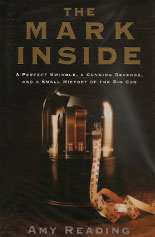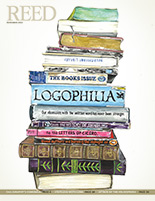
IRIS login | Reed College home Volume 91, No. 4: December 2012
The Books Issue
Hoodwinked
Through a glass, darkly. Amy Reading ’98 has always been fascinated by swindles, lies, and hoaxes.
Ed Dittenhoefer
Historian Amy Reading ’98 recounts a provocative tale of chicanery and vengeance.
By Nadine Fiedler ’89

Amy Reading ’98
The Mark Inside:
A Perfect Swindle, a Cunning Revenge, and a Small History of the Big Con
Knopf, 2012.
They saw him coming.
J. Frank Norfleet was a hardworking, salt-of-the-earth rancher from the Texas panhandle who rode into Dallas in 1919 hoping to sell his farm so he could buy more land. Although respected and successful back home, Norfleet might as well have worn a “Kick Me” sign on his back when he got to the big city. With his homespun clothes, his bandy legs, and his country twang, he was the perfect mark.
And so he was taken, for all he was worth and more, by a smooth-talking swindler named Big Joe Furey, who sucked Norfleet into “the Big Con”—a perfectly executed nine-act charade, with Furey and his accomplices acting out a drama of which Norfleet was painfully oblivious. Every move they made was designed to build his confidence, from the first “accidental” meetings to the tragic climax, where they fled with $45,000 of his money—and then duped him a second time with the same script.
But Furey and his con men underestimated Norfleet. Schooled in the cowboy code of justice, where a deal was sealed by a handshake, Norfleet let nothing stand in his way in his quest to find the swindlers and see them convicted of their crimes. He crisscrossed the country on the flimsiest of leads for years until he found them and made damned sure they paid—every last one.
Amy Reading tells this story with gusto and glee in her book The Mark Inside: A Perfect Swindle, a Cunning Revenge, and a Small History of the Big Con. Her work is based on extensive research, with sources that include J. Frank Norfleet’s autobiography itself. Her powers of observation and imagination, with a precise eye for detail, make her narrative of Norfleet and his quest for vengeance irresistible.
The book is about more than a single individual, however. It is also a history of American swindling, with reflections on the moral shift in the American character from thrift and savings to speculation and personality. Reading takes us along on a compelling tour of humbuggery, P.T. Barnum, counterfeiting, the shady side of Benjamin Franklin, and the undoing of Denver’s most notorious kingpin. “I looked at magazines and the rise of the American middle class. There was a larger transformation over 100 years,” she says. “Gambling was immoral, and it was a vice the lower classes engaged in. Over time, a special definition was carved out for speculation, because it benefited progress. It was a brand-new idea. It was the Big Shift that capitalism scored on the American psyche.”
Reading majored in English at Reed, and went on to earn a doctorate in the literary side of American studies at Yale, where she ran across Norfleet’s memoir while researching her dissertation on swindling. Her fascination with hoaxes is intricately connected with her love of the instabilities inherent in literature.
“Why did I do my dissertation on swindling? I don’t know,” she says. “The answer keeps receding. I was always interested in swindles, lies, and hoaxes. I was very interested in autobiographies that are hoaxes, like when the author is passing for someone else, and ones that dared the reader to look behind the scene. I do a literary-critical type of reading where I don’t take anything at face value. I’m always looking and seeing if I can trust the author’s intention. I like that kind of interplay with the text.” She credits Reed with nourishing those literary impulses. “Reed was just what I needed, given the way my brain is designed. I was always a reader. At Reed I was given the tools and vocabulary to analyze what I am reading.”
Part of what makes The Mark Inside so compelling is Reading’s postmodern stance on the literary text. Her book plays on several levels: she tells the story of Norfleet, she carries it into the history of the dark side of America, and she brings herself into the story as a doubter of Norfleet’s self-narrative: “I’m kind of conning the reader. I wanted the reader to feel brought along, though, and not duped,” she says. With an eyebrow lifted, she points out Norfleet’s incessant and never-ending urge to tell his story and sell himself, the almost desperate bravado and braggadocio with which he portrays himself, and the frankly unbelievable way the story plays out, with coincidences piling on serendipities.
“What I wanted to do was create creative nonfiction to encapsulate both narrative and analysis. It’s an experimental form in the small genre of narrative history,” she says, citing authors such as Erik Larson (The Devil in the White City), Simon Schama, and Jonathan Raban (Bad Land: An American Romance). “There’s a hunger for it,” she says.
Reading now lives in upstate New York with her husband, Jay Farmer ’94, and their children Lucy and Jasper, ages 8 and 5. They first moved to Ithaca when Farmer went to Cornell, and they returned with an infant daughter in tow after Reading worked in publishing in New York and earned her PhD at Yale. Then, she says, “in one spectacular year I finished my dissertation, had my son, and sold my book.”
Ithaca was also where Reading herself was swindled. While she was writing about con artists in the rare book room at Yale, she and Farmer rented their apartment in Ithaca to what seemed like a trustworthy family, one just like hers. It turned out they were con artists, moving on after cheating their landlords and leaving a trail of judgments and debts. Reading and Farmer moved to evict them, but it took time. “During those two months it became the same kind of game of false fronts that I played with them as what I saw in my research. I didn’t let them know that we knew they were defrauding us,” says Reading. She had the same overwhelming reactions Norfleet had, which made her relate to him even more strongly: “Before, I had walked around saying, ‘I’d love to meet a con artist,’ and here I didn’t realize I was being conned. It was puzzling and nauseating. I felt the full range of emotions: befuddlement, anger, outrage, and the righteous need to right injustice.”
In the final analysis, she says, it is a “fragile bubble of hope and optimism” that defines the mark inside—the very requirement for both a life lived to the full and a narrative that keeps readers turning the pages.


LATEST COMMENTS
steve-jobs-1976 I knew Steve Jobs when he was on the second floor of Quincy. (Fall...
Utnapishtim - 2 weeks ago
Prof. Mason Drukman [political science 1964–70] This is gold, pure gold. God bless, Prof. Drukman.
puredog - 1 month ago
virginia-davis-1965 Such a good friend & compatriot in the day of Satyricon...
czarchasm - 4 months ago
John Peara Baba 1990 John died of a broken heart from losing his mom and then his...
kodachrome - 7 months ago
Carol Sawyer 1962 Who wrote this obit? I'm writing something about Carol Sawyer...
MsLaurie Pepper - 8 months ago
William W. Wissman MAT 1969 ...and THREE sisters. Sabra, the oldest, Mary, the middle, and...
riclf - 10 months ago